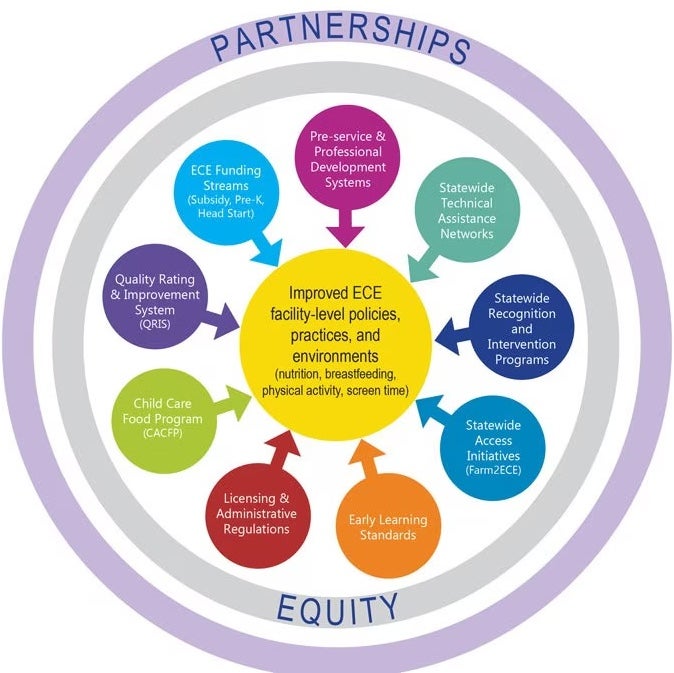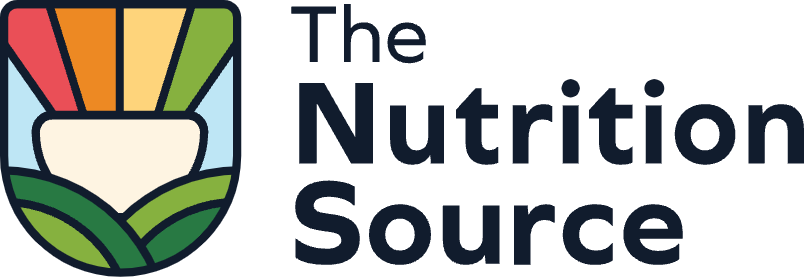
Early childhood (ages 2-5) is an important time for fostering healthy behaviors, as children are developing taste preferences and eating habits that may track into early adolescence and adulthood. Disparities in healthy eating and physical activity habits that influence health also emerge early in life. [1,2]
In the U.S., early childcare and education (ECE) programs provide an important setting for intervention by reaching nearly three-quarters of 3-5 year old children. [3] Federal, state, and local programs, regulations, and policy have the potential to improve the quality of meals and snacks, provide opportunities for physical activity, and limit screen time of early child care programs, and contribute to the formation of healthy habits among young children in their care. [4]

Key resource
Evidence-Based Best Practices for Early Child Care and Education
Evidence suggests that policies and regulations based on best practices related to nutrition, physical activity, and screen time have the greatest potential to improve young children’s health. There are several resources available with evidence-based best practices. Below are a few key topics and strategies in each area related to nutrition, physical activity, and screen time.
Nutrition
- Programs participate or follow the Child and Adult Care Food Program food and beverage guidelines (see below)
- Sugar-sweetened beverages are not served
- No more than 4-6oz of 100% juice is served per day for children aged one to six years
- Safe drinking water is offered throughout the day or in frequent intervals
- Fruits and/or vegetables are served at each eating occasion
- At least half of the grains/breads served in meals and snacks are whole grains
- Grain-based desserts or sugary/sweet foods are served once per week
- Processed and red meats are limited
- Program includes a policy with nutritional guidance/standards for food and beverages brought to the program from home
- Written menus are shared with families and maintained by programs
- Family-style meal service during meals and snack
Physical activity
- Toddlers are provided 60-90 minutes of moderate/vigorous physical activity daily
- Preschoolers are provided 90-120 minutes of moderate/vigorous physical activity daily
- Outdoor play is provided for at least 60 minutes per day
- Safe weather conditions for outdoor play are specified
- Staff provide structured and unstructured physical activity opportunities
- Staff participate in physical activity with children
- Staff are trained in promoting physical activity
Screen time
- No screen time for children younger than 2 years of age
- Less than 30 minutes per week of screen time for children 2-5 years of age
- Any screen time provided must be educational (includes physical education) or children are specifically not allowed to watch marketing of unhealthy foods and beverages
Staff Training
Providing ECE providers with the training, technical assistance, and resources to implement obesity prevention is a critical strategy to ensure that recommendations positively impact child nutrition, physical activity, and screen time behaviors while in their care.
Below are additional resources for providers related to healthy eating, physical activity, and screen time practices among preschool aged children.
Interventions in Early Care and Education
Modifications to childcare programs’ policies around food, physical activity, and screen time appear to be a way to meaningfully impact children’s healthy habit development and obesity risk. In particular, the Nutrition and Physical Activity Self-Assessment for Child Care (NAP SACC) program, which has been widely disseminated throughout the U.S. and is now available online through the Go NAP SACC program, has been shown to be an effective strategy for engaging and empowering child care providers to make healthy changes to their program policies.
Based on existing evidence, promising ECE interventions include those focused on improving the nutritional quality of meals and snacks served in childcare, increasing physical activity opportunities, limiting screen time, and/or providing classroom-based nutrition education. Interventions focusing on children at greatest risk of developing obesity showed highest efficacy, and longer-term follow-up effectiveness studies suggest that booster interventions may be required to ensure that healthy weight is maintained over time. [6,7]
Intervention highlight
Head Start
Head Start is a federal program that promotes the school readiness of infants, toddlers, and preschool-aged children from low-income families; it also may be a powerful program for supporting children’s healthy habit development, reducing their risk of unhealthy weight gain, and addressing health disparities. In addition to early learning and a focus on family overall wellbeing, Head Start Program Performance Standards include requirements related to nutrition and physical activity. [9,10] Updated in 2016, the goal of the standards is to ensure that programs actively engage in obesity prevention processes during the program day, as well as working with families by providing guidance, resources, education, and measurement for the performance standards.
The nutrition and physical activity standards include the following: ensuring meals and snack meet daily nutrition requirements; safe drinking water is freely available to children throughout the day; physical activity is integrated into curricular activities and daily routines; and ensuring that physical activity is not used as a reward or punishment. [10] One national survey indicated that most Head Start programs reported doing more to support healthy eating and physical activity than required by federal guidelines. [11]
In a review of the early child care literature, there a protective effect of Head Start programs for obesity risk among children; this was not seen among other types of child care settings (e.g, centers, relative, or non-relative care). Head Start is highly regulated and has higher nutritional and physical activity standards than what is required by licensed child care programs, and therefore may offer a healthier nutrition, physical activity, and screen time environment. [12] For more detailed information, see the resources below.
Child and Adult Care Food Program
The Child and Adult Care Food Program (CACFP) is another federal program that can influence the diet quality of very young children. CACFP is a federally-funded program administered by states that provides financial support for food service in ECE settings, including child care centers and family day care homes. CACFP is particularly targeted towards young children from households and neighborhoods with lower incomes. Early childcare and education programs apply for CACFP reimbursement for the meals and snacks they serve to eligible families. [13] CACFP subsidizes meals and snacks for over 4 million children each day. [14]
Updated in 2017 as part of the Healthy Hunger Free Kids Act, CACFP regulates the types and quantity of food and beverages served for meals and snacks during child care.[14] Participation in CACFP promotes child care environments that support healthy nutrition, including improved quality of foods and beverages served and/or consumed, including more fruits, vegetables and whole grains, and less juice and refined grains compared to non-participating programs. [15-20]
That said, research suggests that CACFP is not meeting its full potential as a policy to improve children’s diet quality and reduce cardiometabolic disease risk. Studies have found that CACFP is not reaching everyone who could benefit from it: many childcare programs that could participate in CACFP do not do so, and some are not even aware that the program exists. [21] Other research suggests that providers need more financial support from CACFP as well as training and implementation support to provide foods that are optimal for young children’s diet quality. [22] More research is needed to better understand how to best support early child care providers in implementing the CACFP nutrition standards through effective trainings and technical assistance. [15,23]
State Child Care Licensing Standards
State licensing regulations have the potential to promote healthy standards across all licensed child care programs, including healthy eating, the offering daily physical activity, and the limiting of screen time opportunities for children in their care. [24-28] However, most states lack strong regulations relating to the promotion of healthy eating, physical activity and screen time. [29,30]
States have increasingly been including stronger standards in their regulatory language, and there has been an increasing number of states banning sugary beverages served in child care. [29,30,26] However, most states still lack important best practice strategies in their licensing regulation. Furthermore, child care providers require more training and technical assistance on implementing licensing standards.
Below are resources and tools from organizations that have put forward recommended best practice policy standards through state licensing standards in early child care.
Quality Rating and Improvement Standards
The Quality Rating and Improvement Systems (QRIS) were developed as an approach to improve the quality of ECE programming and supplement regulatory approaches to quality. [24,31,32] In addition to the meeting standards set forth by state licensing agencies, QRIS are voluntary systems with the aim of reaching ECE providers, especially those serving low-income children receiving child care subsidies. Training, technical assistance, professional development, and/or financial incentives are often used to encourage providers to meet QRIS standards. [24,31,32] The adoption of voluntary standards around nutrition, physical activity, screen time and/or assessments of health and wellness policies and practices are included in voluntary QRIS program standards have the potential to impact the health of children when attending early child care. [24,32]
Child Care and Development Block Grant
The Child Care and Development Block Grant (CCDBG) Act provides funding to states for child care subsidies for low-income families who are working or participating in education or training activities. [24,33,34] The CCDBG Act also allows for flexibility to pair state and federal funds to improve the overall quality of child care within existing state and local systems.
The law includes provisions specific to nutrition and physical activity, including ensuring that eligible providers are enrolled in CACFP; supporting efforts to develop high-quality nutrition and physical activity standards within licensing requirements or encouraging standards through QRIS; and requiring participating states to disseminate information to families about other food assistance programs (for example, WIC and SNAP).
Related
Last reviewed March 2024

